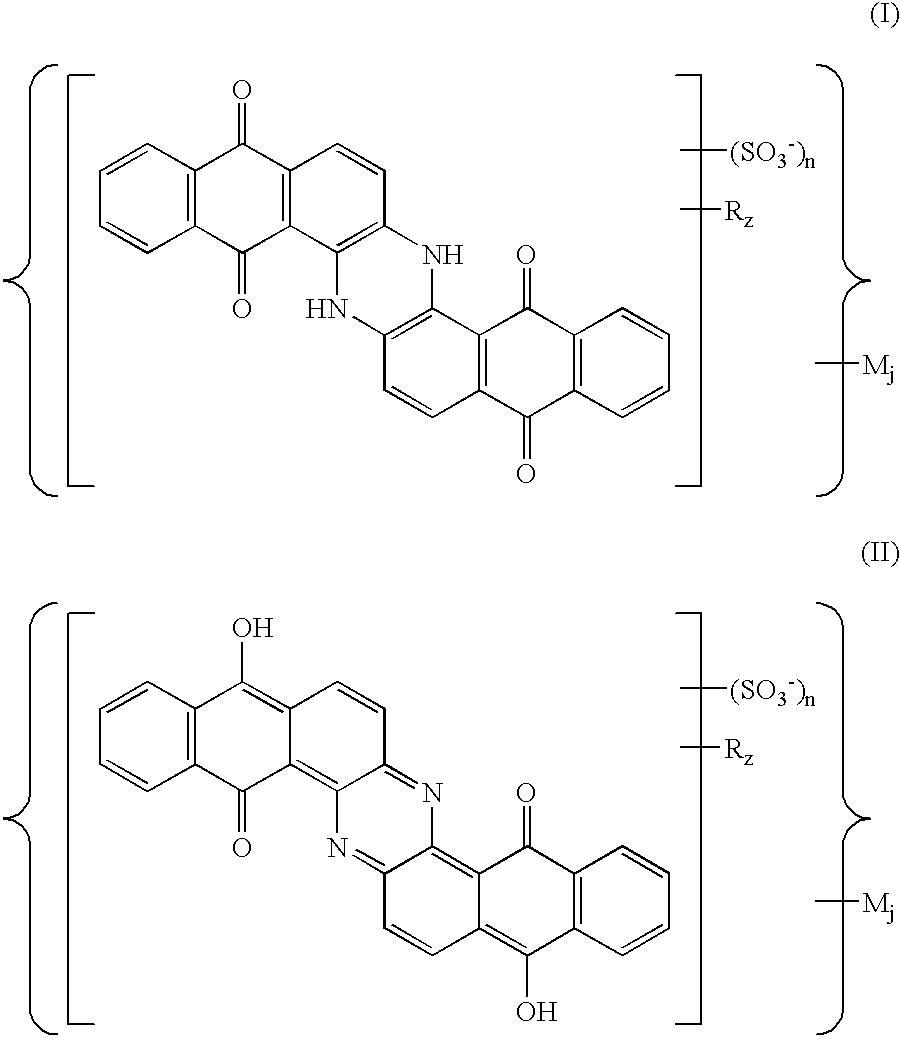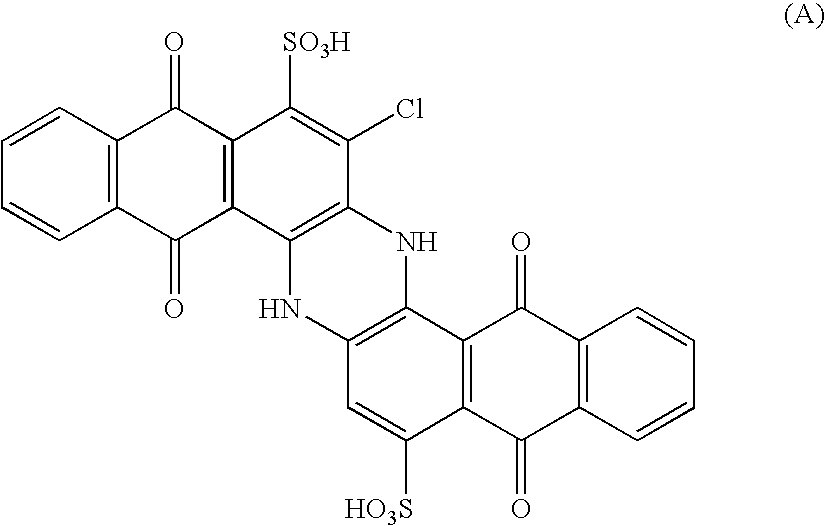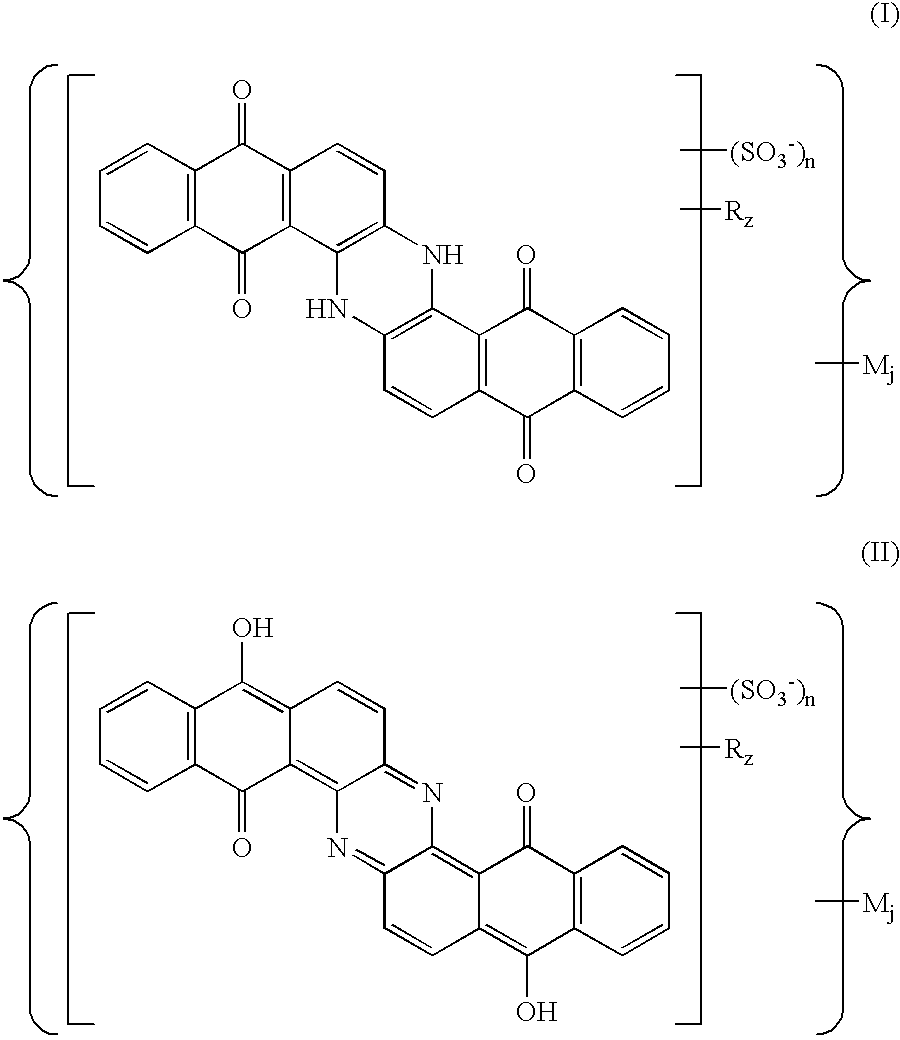Sulfoderivatives of indanthrone, lyotropic liquid crystal system and anisotropic film on their base
- Summary
- Abstract
- Description
- Claims
- Application Information
AI Technical Summary
Benefits of technology
Problems solved by technology
Method used
Image
Examples
example 1
[0049] Trisulfoindanthrone was obtained by the sulfonation of indanthrone and the further precipitation of the indanthrone trisulfoacid as follows.
[0050] Step 1A: Sulfonation.
[0051] 50 g of indanthrone was introduced to the mixture of 100 ml of 30% oleum and 30 ml of the chlorosulfonic acid. The mixture was heated to 100-110° C. The reaction mixture was maintained at this temperature for 15 hours. The processs yielded a mixture of indanthrone tri- and tetrasulfoderivatives at a ratio 3:1.
[0052] Step 1B: Precipitation of Indanthrone Trisulfoacid.
[0053] The reaction mixture was cooled, two-fold diluted, first with 92% sulfuric acid and then with water to the rated sulfuric acid concentration 80%. The formed precipitate was filtered, diluted with 2 liters of water, and then boiled for 6 hours. After neutralization with ammonia and ultrafiltration, the process yielded an aqueous solution of indanthrone trisulfoacid ammonium salt containing 48 g of the desired product. The ammonium s...
example 2
[0055] Tetrasulfoindanthrone was obtained by the sulfonation of indanthrone and the further precipitation of the indanthrone tetrasulfoacid.
[0056] Step 2A: Sulfonation.
[0057] Indanthrone was sulfonated using the same procedure that described in Example 1A.
[0058] Step 2B: Precipitation of Indanthrone Tetrasulfoacid.
[0059] Indanthrone tetrasulfoacid was precipitated from a sulfuric-acid mother liquor after the separation of the trisulfoacid. The mother liquor was neutralized with ammonia and purified from inorganic salts by ultrafiltration. The process yielded an aqueous solution of indanthrone tetrasulfoacid ammonium salt containing 25 g of tetrasulfoderivative.
[0060] The indanthrone tetrasulfoacid was produced from the ammonium salt by an ion exchange in the course of which 500 ml of 1% ammonium salt solution passed through 100 g of ion-exchange resin. The produced solution was concentrated under vacuum and dried. The process yielded 4.7 g of indanthrone tetrasulfoacid of a str...
example 3
[0061] Trisulfochloroindanthrone was synthesized by sulfonation of trisulfoindanthrone. 4 ml of 50% nitric acid were introduced to a trisulfoindanthrone solution containing 13.6 g in 200 ml of 92% sulfuric acid. The solution was stirred to the complete oxidation of trisulfoindanthrone—until the solution acquired yellow color. Dry HCl was passed through the resultant solution at 50° C. for 12 hours. The reaction mixture was diluted with 300 ml of water, the precipitate was filtered and then boiled in 1 liter of water for 3 hours. After neutralization and ultrafiltration the process yielded an aqueous solution of trisulfoindanthrone containing 13 g of trisulfochloroindanthrone ammonium salt with the formula:
The electron spectrum (spectrometer Ocean PC 2000, aqueous solution) of the sample had λmax=680 nm. Infrared spectrum (IR-spectrum, IR-Fourier spectrometer FSM -1201, film on the windows KRS-5) peaks were located at 1034.0, 1182.4 (SO3H), and 1647.5 cm−1(C═O). The mass-spectrum ...
PUM
 Login to View More
Login to View More Abstract
Description
Claims
Application Information
 Login to View More
Login to View More - R&D
- Intellectual Property
- Life Sciences
- Materials
- Tech Scout
- Unparalleled Data Quality
- Higher Quality Content
- 60% Fewer Hallucinations
Browse by: Latest US Patents, China's latest patents, Technical Efficacy Thesaurus, Application Domain, Technology Topic, Popular Technical Reports.
© 2025 PatSnap. All rights reserved.Legal|Privacy policy|Modern Slavery Act Transparency Statement|Sitemap|About US| Contact US: help@patsnap.com



